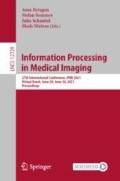Abstract
Finite Element Analysis (FEA) is useful for simulating Transcather Aortic Valve Replacement (TAVR), but has a significant bottleneck at input mesh generation. Existing automated methods for imaging-based valve modeling often make heavy assumptions about imaging characteristics and/or output mesh topology, limiting their adaptability. In this work, we propose a deep learning-based deformation strategy for producing aortic valve FE meshes from noisy 3D CT scans of TAVR patients. In particular, we propose a novel image analysis problem formulation that allows for training of mesh prediction models using segmentation labels (i.e. weak supervision), and identify a unique set of losses that improve model performance within this framework. Our method can handle images with large amounts of calcification and low contrast, and is compatible with predicting both surface and volumetric meshes. The predicted meshes have good surface and correspondence accuracy, and produce reasonable FEA results.
Access this chapter
Tax calculation will be finalised at checkout
Purchases are for personal use only
References
Balakrishnan, G., Zhao, A., Sabuncu, M.R., Guttag, J., Dalca, A.V.: Voxelmorph: a learning framework for deformable medical image registration. IEEE Trans. Med. Imaging 38(8), 1788–1800 (2019)
Chui, H., Rangarajan, A.: A new point matching algorithm for non-rigid registration. Comput. Vis. Image Underst. 89(2–3), 114–141 (2003)
Dowling, C., Firoozi, S., Brecker, S.J.: First-in-human experience with patient-specific computer simulation of TAVR in bicuspid aortic valve morphology. JACC Cardiovasc. Interven. 13(2), 184–192 (2020)
Fedorov, A., et al.: 3D slicer as an image computing platform for the quantitative imaging network. Magn. Reson. Imaging 30(9), 1323–1341 (2012)
Ghesu, F.C., et al.: Marginal space deep learning: efficient architecture for volumetric image parsing. IEEE Trans. Med. imaging 35(5), 1217–1228 (2016)
Gkioxari, G., Malik, J., Johnson, J.: Mesh R-CNN. In: Proceedings of the IEEE International Conference on Computer Vision, pp. 9785–9795 (2019)
Ionasec, R.I., et al.: Patient-specific modeling and quantification of the aortic and mitral valves from 4-D cardiac CT and tee. IEEE Trans. Med. Imaging 29(9), 1636–1651 (2010)
Jacobson, A., Panozzo, D., et al.: libigl: A simple C++ geometry processing library (2018). https://libigl.github.io/
Kingma, D.P., Ba, J.: Adam: A method for stochastic optimization. arXiv preprint arXiv:1412.6980 (2014)
Lee, M.C.H., Petersen, K., Pawlowski, N., Glocker, B., Schaap, M.: Tetris: template transformer networks for image segmentation with shape priors. IEEE Trans. Med. Imaging 38(11), 2596–2606 (2019)
Liang, L., et al.: Machine learning-based 3-D geometry reconstruction and modeling of aortic valve deformation using 3-D computed tomography images. Int. J. Numer. Methods Biomed. Eng. 33(5), e2827 (2017)
Loriot, S., Rouxel-Labbé, M., Tournois, J., Yaz, I.O.: Polygon mesh processing. In: CGAL User and Reference Manual. CGAL Editorial Board, 5.1.1 edn. (2020). https://doc.cgal.org/5.1.1/Manual/packages.html#PkgPolygonMeshProcessing
Pak, D.H., Caballero, A., Sun, W., Duncan, J.S.: Efficient aortic valve multilabel segmentation using a spatial transformer network. In: 2020 IEEE 17th International Symposium on Biomedical Imaging (ISBI), pp. 1738–1742. IEEE (2020)
Papademetris, X., et al.: Bioimage suite: an integrated medical image analysis suite: an update. Insight J. 2006, 209 (2006)
Paszke, A., et al.: Automatic differentiation in pytorch (2017)
Pouch, A.M., et al.: Medially constrained deformable modeling for segmentation of branching medial structures: application to aortic valve segmentation and morphometry. Med. Image Anal. 26(1), 217–231 (2015)
Ravi, N., et al.: Accelerating 3D deep learning with pytorch3d. arXiv:2007.08501 (2020)
Ronneberger, O., Fischer, P., Brox, T.: U-Net: convolutional networks for biomedical image segmentation. In: Navab, N., Hornegger, J., Wells, W.M., Frangi, A.F. (eds.) MICCAI 2015, Part III. LNCS, vol. 9351, pp. 234–241. Springer, Cham (2015). https://doi.org/10.1007/978-3-319-24574-4_28
Rueckert, D., Sonoda, L.I., Hayes, C., Hill, D.L., Leach, M.O., Hawkes, D.J.: Nonrigid registration using free-form deformations: application to breast MR images. IEEE Trans. Med. Imaging 18(8), 712–721 (1999)
Sandkühler, R., Jud, C., Andermatt, S., Cattin, P.C.: Airlab: Autograd image registration laboratory. arXiv preprint arXiv:1806.09907 (2018)
Schroeder, W.J., Lorensen, B., Martin, K.: The Visualization Toolkit: An Object-Oriented Approach to 3D Graphics. Kitware, NewYork (2004)
Sun, W., Martin, C., Pham, T.: Computational modeling of cardiac valve function and intervention. Annu. Rev. Biomed. Eng. 16, 53–76 (2014)
Wang, N., Zhang, Y., Li, Z., Fu, Y., Liu, W., Jiang, Y.G.: Pixel2Mesh: generating 3D mesh models from single RGB images. In: Proceedings of the European Conference on Computer Vision (ECCV), pp. 52–67 (2018)
Wang, Q., Primiano, C., McKay, R., Kodali, S., Sun, W.: CT image-based engineering analysis of transcatheter aortic valve replacement. JACC Cardiovasc. Imaging 7(5), 526–528 (2014)
Zhuang, X., Shen, J.: Multi-scale patch and multi-modality atlases for whole heart segmentation of MRI. Med. Image Anal. 31, 77–87 (2016)
Acknowledgments and Conflict of Interest
This work was supported by the NIH R01HL142036 grant. Dr. Wei Sun is a co-founder and serves as the Chief Scientific Advisor of Dura Biotech. He has received compensation and owns equity in the company.
Author information
Authors and Affiliations
Corresponding author
Editor information
Editors and Affiliations
Rights and permissions
Copyright information
© 2021 Springer Nature Switzerland AG
About this paper
Cite this paper
Pak, D.H. et al. (2021). Weakly Supervised Deep Learning for Aortic Valve Finite Element Mesh Generation from 3D CT Images. In: Feragen, A., Sommer, S., Schnabel, J., Nielsen, M. (eds) Information Processing in Medical Imaging. IPMI 2021. Lecture Notes in Computer Science(), vol 12729. Springer, Cham. https://doi.org/10.1007/978-3-030-78191-0_49
Download citation
DOI: https://doi.org/10.1007/978-3-030-78191-0_49
Published:
Publisher Name: Springer, Cham
Print ISBN: 978-3-030-78190-3
Online ISBN: 978-3-030-78191-0
eBook Packages: Computer ScienceComputer Science (R0)

